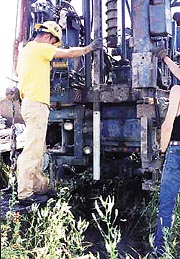
This article series identifies and summarizes experiences with proven aboveground treatment alternatives for arsenic in ground water, and provides information on their relative effectiveness and cost. This will help:
- identify proven and effective treatment technologies
- screen those technologies based on effectiveness, treatment goals, site characteristics and cost
- apply technology and experience from sites with similar remediation challenges
- find more detailed arsenic treatment information.
This first article addresses precipitation and coprecipitation. Subsequent articles will get into adsorption, ion exchange and membrane filtration.
Most Frequent Method
Precipitation/coprecipitation has been the most frequently used method to treat arsenic-contaminated water, including ground water, surface water, leachate, mine drainage, drinking water and wastewater in numerous pilot- and full-scale applications. This technology typically can reduce arsenic concentrations to less than 0.05 mg/L and, in some cases, has reduced concentrations below 0.01 mg/L.Technologies are considered precipitation/coprecipitation if they involve the following steps:
- mixing of treatment chemicals into the water;
- formation of a solid matrix through precipitation, coprecipitation or a combination of the two processes; and
- separation of the solid matrix from the water.
Precipitation uses chemicals to transform dissolved contaminants into an insoluble solid. In coprecipitation, the target contaminant may be dissolved in a colloidal or suspended form. Dissolved contaminants do not precipitate, but are adsorbed onto another species that is precipitated. Colloidal or suspended contaminants become enmeshed with other precipitated species, or are removed through processes such as coagulation and flocculation. Many processes to remove arsenic from aqueous matrices involve a combination of precipitation and coprecipitation. The precipitated/coprecipitated solid then is removed from the liquid phase by clarification or filtration.
Complex Chemistry
The chemistry of precipitation/coprecipitation often is complex and depends upon a variety of factors, including the speciation of arsenic, the chemical precipitants used and their concentrations, the pH of the water and the presence of other chemicals in the water to be treated. As a result, the particular mechanism that results in the removal of arsenic through precipitation/coprecipitation treatment is process-specific and, in some cases, is not completely understood.Arsenic precipitation/coprecipitation can use combinations of chemicals and methods.
Contaminants treated:
- inorganics
- suspended solids
- colloids
Arsenic-contaminated media treated:
- drinking water
- ground water
- wastewater
- surface water
- leachate
- mine drainage
Chemicals/methods employed:
- ferric salts, ferric sulfate and ferric hydroxide
- aluminum sulfate and aluminum hydroxide
- pH adjustment
- lime softening, limestone, calcium hydroxide
- manganese sulfate
- copper sulfate
- sulfide
Three primary factors affect the performance of precipitation/coprecipitation in treating arsenic:
Valence state of arsenic – The presence of the more soluble trivalent state of arsenic might reduce the removal efficiency. The solubility of arsenic depends upon its valence state, pH, the specific arsenic compound and the presence of other chemicals with which arsenic might react. Oxidation of trivalent arsenic to its less soluble pentavalent state could improve arsenic removal through precipitation/coprecipitation.
pH – In general, arsenic removal will be maximized at the pH at which the precipitated species is least soluble. The optimal pH range for precipitation/coprecipitation depends upon the waste treated and the specific treatment process.
Presence of other compounds – The presence of other metals or contaminants can impact the effectiveness of precipitation/coprecipitation. For example, sulfate could decrease arsenic removal in processes using ferric chloride as a coagulant, while the presence of calcium or iron may increase the removal of arsenic in these processes.
Precipitation/coprecipitation is an active in situ treatment designed to function with routine chemical addition and sludge removal. Usually, it requires treatment such as dewatering and subsequent disposal. Some sludge from the precipitation/coprecipitation of arsenic can be a hazardous waste and require additional treatment such as solidification/stabilization prior to disposal. In the presence of other metals or contaminants, arsenic precipitation/coprecipitation processes might cause other compounds to precipitate, which can render the resulting sludge hazardous the effluent also may require further treatment, such as pH adjustment, prior to discharge or reuse.
Other Cost Factors
Four key factors that affect the costs of precipitation/coprecipitation:
- The chemical added will affect costs. For example, calcium hypochlorite is a less expensive oxidant than potassium permanganate.
- The cost generally increases with increased chemical addition. Larger amounts of chemicals added usually results in a larger amount of sludge, requiring additional treatment or disposal.
- Application could require additional treatment to meet stringent cleanup goals and/or effluent and disposal standards.
- Sludge produced from the precipitation/coprecipitation process could be considered a hazardous waste and require additional treatment before disposal, or require disposal as a hazardous waste.
Report Abusive Comment